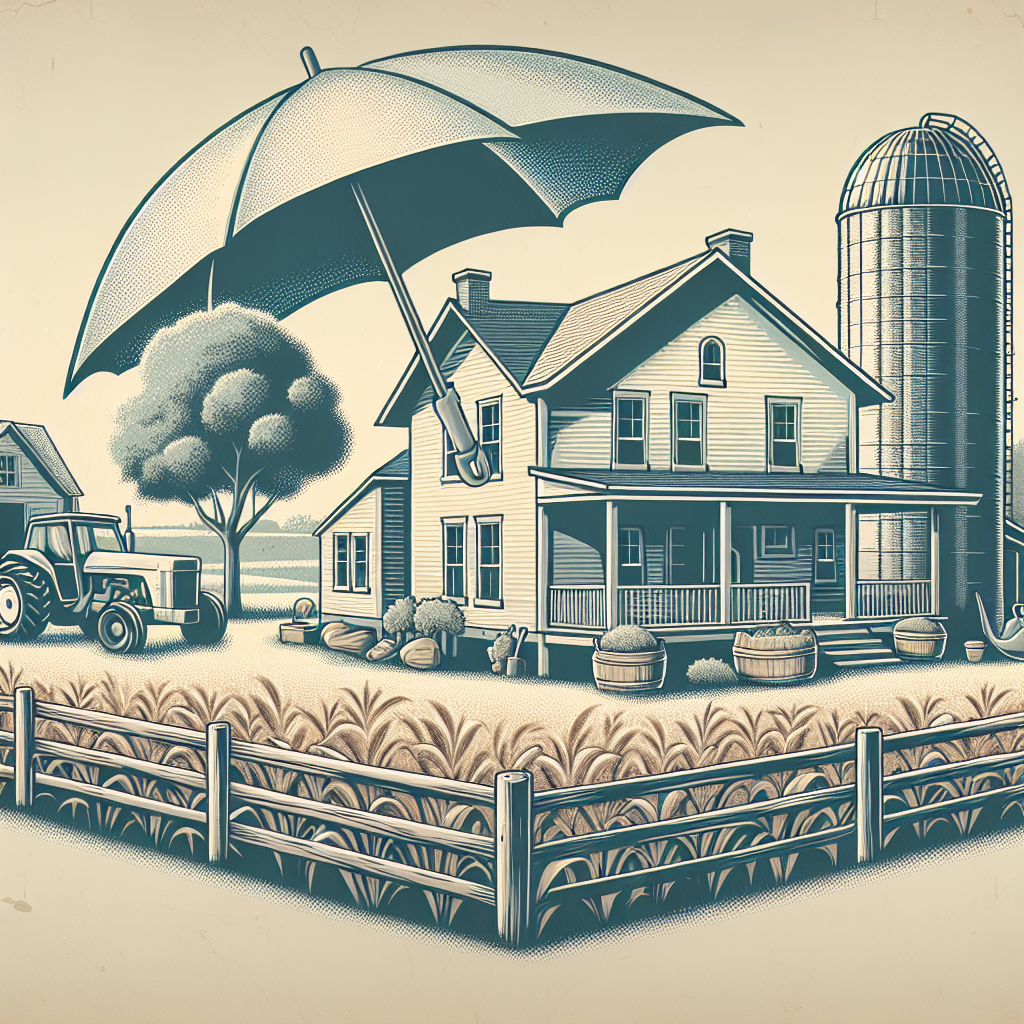Filed under Home Insurance on
Farm Bureau Home Insurance Coverage Guide

Your step-by-step guide to confident coverage decisions
Home insurance isn’t just a policy—it’s a plan for bouncing back when the unexpected happens. If you live in a state where Farm Bureau companies operate, you’ve likely heard friends or neighbors talk about the local agents and community-first approach. This guide breaks down what a typical policy covers, common add-ons, ways to save, and how to tailor protection for both suburban homes and rural properties. Whether you’re a first-time buyer or revisiting your coverage, understanding the details of Farm Bureau home insurance will help you make smarter choices.
How Farm Bureau insurance works at the state level
Farm Bureau insurance companies are independent entities that operate by state or region. That means product options, underwriting rules, available discounts, and even membership requirements can vary. In many places, buying a policy also requires a Farm Bureau membership. The membership typically comes with additional benefits—like community programs and agricultural advocacy—beyond insurance access.
What’s consistent across states is the emphasis on local agents who know regional building costs, weather patterns, and claim trends. That local knowledge can make a meaningful difference when setting coverage limits or navigating a claim. If you’re considering Farm Bureau home insurance, start by connecting with an agent in your state to understand what’s available where you live.
What a standard homeowners policy usually covers
Most policies are built around the familiar homeowners framework, often referred to as HO-3 or a similar form. While details may differ by state, the core components typically include the following sections.
Dwelling (Coverage A)
This is the backbone of your policy. It covers the home’s structure—walls, roof, flooring, built-in appliances—against covered perils like fire, wind, and theft. The goal is to insure your home to its estimated replacement cost, not market value. Replacement cost is what it takes to rebuild at today’s prices, including materials and labor, which can be higher than the home’s listing price.
Other structures (Coverage B)
Detached structures like sheds, fences, barns, and detached garages fall here. Coverage limits often start as a percentage of your dwelling coverage. If you have extensive outbuildings—common on rural properties—ask your agent about boosting this limit or transitioning to a farm or ranch policy structure if needed.
Personal property (Coverage C)
This covers your belongings, from furniture and electronics to clothing. Many policies default to replacement cost for personal property if you add that endorsement; otherwise, coverage may be on an actual cash value basis, which subtracts for depreciation. High-value items such as jewelry, collectibles, or firearms have sublimits. Consider scheduling items for broader protection.
Loss of use (Coverage D)
If a covered claim forces you to leave your home temporarily, loss of use can cover additional living expenses like short-term housing and increased meal costs. It’s especially important after major events such as wildfire, tornado, or hailstorms that require extended repairs.
Personal liability (Coverage E)
Liability coverage protects you if you’re legally responsible for injury or property damage to others, on or off your property. It can help cover legal defense and settlements up to your limit. Many homeowners choose higher limits and add a personal umbrella policy for added protection.
Medical payments to others (Coverage F)
This pays for minor medical costs if a guest is injured at your home, regardless of fault. It’s not a substitute for liability coverage, but it can reduce the likelihood of small incidents turning into larger claims.
Key endorsements and add-ons to consider
Endorsements let you personalize your policy. With Farm Bureau home insurance, your local agent can tailor recommendations based on your home’s age, location, and risk profile.
- Extended or guaranteed replacement cost: Adds a cushion above your dwelling limit if rebuilding costs spike after a catastrophe. This can be critical when construction costs surge.
- Ordinance or law: Helps cover the added expense of rebuilding to current codes after a covered loss.
- Water backup and sump overflow: Covers damage from backups through sewers or drains. Standard policies often exclude this without an endorsement.
- Service line coverage: Helps pay to repair underground utility lines you own, like water, sewer, or power lines, which are typically excluded.
- Equipment breakdown: Extends coverage to household systems and appliances from sudden mechanical or electrical failure.
- Scheduled personal property: Provides broader protection and higher limits for items like jewelry, art, or musical instruments.
- Home business or incidental business: If you run a small business from home, you may need added coverage for equipment and liability.
- Identity theft expense coverage: Helps with costs and support if your identity is compromised.
- Wind/hail and roof replacement options: In hail-prone areas, you may see roof-specific deductibles or settlement types; review carefully.
- Earthquake and flood: Typically excluded from standard policies. Flood is often obtained through the National Flood Insurance Program or private markets; earthquake can be added in some states or purchased separately.
Choosing the right limits: valuation and sublimits explained
The most common coverage gaps arise from undervaluation. Here’s how to dial in limits that better fit your needs.
Setting your dwelling limit
Work with your agent to run a replacement cost estimator. Provide details about your home’s square footage, finishes, roof type, and unique features. Update your limits after renovations or material-cost spikes. Underinsuring can lead to coinsurance penalties or insufficient funds to rebuild to pre-loss condition.
Personal property and special sublimits
Personal property is often set as a percentage of your dwelling limit. Even so, sublimits apply to categories like jewelry, firearms, cash, silverware, and collectibles. If your valuables exceed those sublimits, schedule them. It’s generally inexpensive and can broaden protection to include accidental loss.
Replacement cost vs. actual cash value
Replacement cost coverage for both the dwelling and personal property generally provides stronger protection than actual cash value, which accounts for depreciation. Ask how your policy treats roofs, as some carriers apply actual cash value to older roofs unless you add endorsements or upgrade materials.
Deductibles: flat and percentage options
Deductibles reduce small-claim frequency and affect premium. In many regions, wind or hail may carry a separate, higher deductible—sometimes a percentage of the dwelling limit. Choose a level that balances affordability with risk tolerance, and always confirm how many deductibles apply if multiple perils are involved.
Ways to save without sacrificing protection
Premiums are rising nationwide due to inflation, reinsurance costs, and weather severity. The right mix of discounts and risk improvements can help stabilize costs.
- Bundle and multi-policy: Combining homeowners and auto is a common way to save. Adding umbrella or a second property may also help.
- Protective devices: Monitored alarms, water-leak sensors, smart thermostats, and deadbolts can earn discounts and reduce losses.
- Roof upgrades: Impact-resistant shingles can reduce hail damage and might qualify for credits in some states.
- Claims-free history: Maintaining a clean record often unlocks better pricing.
- New home or renovation credits: Newer construction or updates to roofing, plumbing, electrical, and HVAC may earn price breaks.
- Membership benefits: In states requiring membership, ask if additional perks or local programs apply.
Your agent can run scenarios: raising deductibles modestly, adding smart sensors, or scheduling high-value items can sometimes lower premiums or improve coverage per dollar.
What industry trends mean for your policy
Home insurance is evolving rapidly. Increased catastrophic weather, higher construction costs, and reinsurance pressures have led many carriers to recalibrate pricing, underwriting, and coverage terms. Analysts and trade groups have noted:
- More granular underwriting by geography and even roof age or material.
- Stricter rules for properties in wildfire, wind, or flood zones.
- Broader use of separate wind/hail deductibles in storm-prone states.
- Emphasis on mitigation—insurers increasingly reward risk-reducing upgrades.
Against this backdrop, the local-agent model used by many Farm Bureau companies can be an advantage. Agents often understand which upgrades carry the most impact in your area and how to structure Farm Bureau home insurance for resilience and value.
Rural homes and small-acreage properties: unique considerations
Rural properties sometimes straddle the line between a standard homeowners policy and a farm or ranch package. Even hobby operations—like selling eggs, keeping a few head of livestock, or hosting agritourism events—can change your risk profile. Talk candidly with your agent about:
- Outbuildings and barns: Ensure your other structures limit matches the value of detached buildings and stored tools.
- Farm personal property: Tractors, UTVs, implements, and livestock may require specialized coverage.
- Liability: Animal exposures, farm stand sales, or on-site events may need farm liability or an umbrella policy.
- Fencing, corrals, and water systems: These can be costly to repair after storms or wildfire; ask how they’re covered.
- Home-based businesses: If you run a business from your property, you may need separate endorsements or a distinct policy form.
Not every rural property needs a full farm policy, but many benefit from endorsements tailored to non-urban risks. This is a hallmark of working with a local agent who can pivot from standard home coverage to farm and ranch solutions when needed.
Claims: what to expect and how to prepare
When a loss occurs, being prepared can smooth the process. Farm Bureau home insurance is supported by state-based teams and local agents who can guide you through each step. Here’s a general roadmap:
- Safety first: Ensure everyone is safe and call emergency services if needed. Prevent further damage by making temporary repairs.
- Document the loss: Take photos and video, keep damaged items if safe to do so, and save receipts for temporary repairs or lodging.
- Contact your agent or claims center: Report the claim promptly and follow their instructions.
- Adjuster evaluation: An adjuster will inspect damages and discuss coverage; share your documentation and any contractor estimates.
- Settlement and repair: Review settlement details, confirm deductibles, and coordinate with contractors. Choose licensed and insured professionals.
Keeping a home inventory—photos, serial numbers, and approximate values—can speed up contents claims and improve accuracy. There are simple mobile apps and spreadsheets that make this task manageable.
Comparing quotes the right way
Price matters, but coverage terms can differ widely. When you compare Farm Bureau home insurance to other quotes, use an apples-to-apples checklist:
- Dwelling limit and valuation method: Are both based on current replacement cost?
- Roof settlement: Replacement cost or actual cash value? Any roof-age restrictions?
- Deductibles: Flat vs. percentage, and separate wind/hail deductibles if applicable.
- Endorsements: Extended replacement cost, water backup, service line, equipment breakdown.
- Personal property: Replacement cost and key sublimits for jewelry, firearms, collectibles.
- Liability and umbrella: Overall protection for high-cost incidents.
- Discounts and mitigation credits: What steps lower your premium now and in the future?
Finally, review the carrier’s financial strength with an independent agency like AM Best, and ask about local claims performance after recent storms or wildfires. Local feedback is invaluable.
Risk reduction checklist for every homeowner
Loss prevention helps protect your home and can improve your insurability. Consider these practical steps:
- Roofing: Install impact-resistant shingles in hail areas; schedule regular inspections and prompt repairs.
- Water defense: Add automatic shutoff valves and leak sensors near washing machines, water heaters, and sinks. Maintain gutters and slope soil away from the foundation.
- Electrical and plumbing updates: Older systems increase loss potential; modernize to reduce risk and possibly earn credits.
- Wildfire hardening: Create defensible space, use fire-resistant vents and Class A roofing where appropriate.
- Security: Monitored alarms, cameras, smart locks, and adequate lighting deter theft and speed emergency response.
- Maintenance schedule: Seasonal checklists for HVAC servicing, chimney cleaning, and sump pump testing prevent costly surprises.
Where Farm Bureau fits into today’s market
Consumers increasingly want a blend of robust coverage, practical pricing, and responsive claims service. The state-based model of Farm Bureau companies often emphasizes agent relationships and community presence. For many households, that combination translates to clearer advice, coverage tailored to local risks, and a more predictable experience when it’s time to file a claim. If you value face-to-face guidance and local expertise, Farm Bureau home insurance can be a strong contender.
Frequently asked questions
Do I need a Farm Bureau membership to buy a policy?
In many states, yes. Membership requirements and dues vary by location. Membership often includes additional benefits beyond insurance access, such as community programs and advocacy initiatives. Your local office can clarify what applies in your area.
How do I know if my home is insured to the right value?
Ask your agent to run a detailed replacement cost estimate and update it every year or after renovations. Keep your agent informed about material upgrades, additions, or energy-efficient improvements that affect reconstruction cost.
Are floods and earthquakes covered?
Standard policies typically exclude flood and earthquake. Flood coverage is commonly purchased through the National Flood Insurance Program or private markets. Earthquake can sometimes be added by endorsement or via a separate policy, depending on the state.
Can I get coverage for a home-based business?
Yes, but you may need specific endorsements or a separate policy depending on your operations and equipment. Disclose any business activity at home so your agent can recommend proper protection.
What about older roofs?
Insurers increasingly differentiate by roof age and material. Some policies settle older roofs at actual cash value unless you upgrade coverage or materials. Ask how your policy treats roof claims and whether impact-resistant shingles qualify for credits.
How do I reduce premiums without underinsuring?
Combine loss-prevention steps (leak sensors, alarms, roof upgrades) with smart policy choices (appropriate deductibles, scheduling valuables, and bundling). Review annually to adjust limits with inflation and avoid gaps.
Is Farm Bureau financially strong?
Financial strength varies by the state-based company. Review current ratings from independent agencies like AM Best and ask your agent about claims performance in your region.
Putting it all together: a simple action plan
Use this quick plan to make sure your coverage matches your life today:
- Inventory your home: Photograph rooms, note serial numbers, and estimate values for high-cost items.
- Verify your dwelling limit: Confirm a current replacement cost estimate that reflects local labor and material costs.
- Close coverage gaps: Consider extended replacement cost, water backup, service line, and scheduled property endorsements.
- Dial in deductibles: Balance premium savings with what you can comfortably pay out of pocket.
- Fortify your home: Add leak sensors, upgrade roofing where practical, and maintain defensible space in wildfire zones.
- Bundle and review: Explore multi-policy discounts and meet annually with your agent to adjust for life changes.
Final word and next steps
The best homeowners policies are built, not bought. They reflect your property’s unique risks, the realities of today’s construction costs, and your tolerance for out-of-pocket expenses. With its local-agent model and state-focused approach, Farm Bureau home insurance can be an excellent option for homeowners who want tailored coverage and guidance they can trust. If you’re ready to refine your protection, connect with a Farm Bureau agent in your state, request a side-by-side comparison, and ask about endorsements that strengthen resilience in your region. A short conversation now can make a major difference when you need it most.




